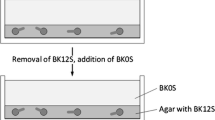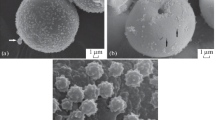Summary
Growth of pollen tubes ofNicotiana tabacum W 38 in a defined liquid medium buffered at pH 5.9 and containing sucrose, amino-acids, boric acid, salts and an antibacterial agent was stimulated by the addition of poly(ethylene glycol) 6000 (PEG-6000) and Cu(II) salts. In the absence of both these supplements, up to 50% of the hydrated pollen grains did not develop further, and the germinated tubes were slow-growing and abnormal, with thickened walls, kinked growth, and fragile, swollen tips containing granular cytoplasm. Addition of 10–15% (w/v) purified PEG-6000 increased germination to 80–90% and prevented the progressive bursting of pollen grains and tube tips, but growth was still slow and kinked and tips remained swollen. Addition of 30 μM CuSO4 did not stimulate germination or prevent tip bursting, but produced straight-growing tubes with smooth-sided tips resembling the tips of tubes growing through stylar tissue; the free Cu2+ concentration under these conditions was about 1.0 μM due to chelation by amino-acids, and similar tube morphologies were obtained with 1.0–1.5 μM added CuSO4 when NH4Cl replaced the amino-acids. When the medium containing amino-acids was supplemented with both 12.5% PEG-6000 and 30 μM CuSO4, long-term (48 h) growth of straight pollen tubes with smooth-sided tips, thin walls and long ladders of callose plugs was observed; growth occurred at 250 μm/h, approximately 30–40% of the rate observed in the style. Although omission of CuSO4 from this complete medium severely affected tube growth and callose plug deposition, it did not alter the timing of generative-nucleus division, and thus the different parameters associated with the second phase of pollen-tube growth can be uncoupled in culture. High levels of FeSO4 (300 μM) had a similar morphogenetic effect to CuSO4, but addition of 300 μM L-ascorbate or D-iso-ascorbate was required to prevent precipitation of Fe(III) oxide and prolong the stimulation of pollen-tube growth; EDTA removed the morphogenetic effect of both CuSO4 and FeSO4. Further, an impure grade of PEG-4000 was contaminated with an organic morphogen that allowed continued slow growth of pollen tubes with smooth, straight-sided tips in the absence of added CuSO4 or FeSO4, with tube morphology unaffected by ascorbate or EDTA. However, the long-term morphogenetic effect of trace levels of CuSO4 suggests that Cu(II) salts play an important role in pollen-tube development in at least this species ofNicotiana.
Similar content being viewed by others

Abbreviations
- A475 :
-
absorbance at 475 nm
- DAPI:
-
4′,6-diamidino-2-phenylindole
- EDTA:
-
ethylene-diamine N,N,N′,N′-tetraacetic acid
- MES:
-
2-(N-morpholino)-ethane sulphonic acid
- OG:
-
‘ordinary grade’ of poly(ethylene glycol)
- PEG:
-
poly(ethylene glycol)
- SP:
-
‘Specially Purified for Biochemistry’ grade of poly(ethylene glycol)
References
Bar-Shalom D, Mattsson O (1976) Mode of hydration, an important factor in the germination of trinucleate pollen grains. Bot Tidssk 71: 245–251
Bressan RA, Hasegawa PM, Handa AK (1981) Resistance of cultured higher plant cells to polyethylene glycol-induced water stress. Plant Sci Lett 21: 23–30
Brewbaker JL (1959) Biology of the angiosperm pollen grain. Ind J Genet Plant Breeding 19: 121–133
— (1967) The distribution and phylogenetic significance of binucleate and trinucleate pollen grains in the angiosperms. Amer J Bot 54: 1069–1083
—, Kwack BH (1963) The essential role of calcium ion in pollen germination and tube growth. Amer J Bot 50: 859–865
—, Majumder SK (1961) Cultural studies of the pollen population effect and the self-incompatibility inhibition. Amer J Bot 48: 457–464
Broothaerts W, Vanvinckenroye P, Decock B, Van Damme J, Vendrig JC (1991)Petunia hybrida S-proteins: ribonuclease activity and the role of their glycan side chains in self-incompatibility. Sex Plant Reprod 4: 258–266
Capkova-Balatkova V, Hrabetova E, Tupy J (1980) Effect of some mineral ions on pollen tube growth and release of proteins in culture. Biol Plant 22: 294–302
Cresti M, Pacini E, Ciampolini F, Sarfatti G (1977) Germination and early tube development in vitro ofLycopersicon peruvianum pollen: ultrastructural features. Planta 136: 239–247
—, Ciampolini F, Sarfatti G (1980) Ultrastructural investigations onLycopersicon peruvianum pollen activation and pollen tube organisation after self-and cross-pollination. Planta 150: 211–217
— —, Mulcahy DLM, Mulcahy G (1985) Ultrastructure ofNicotiana alata pollen, its germination and early tube formation. Amer J Bot 72: 719–727
— —, Tiezzi A (1986) Ultrastructural studies onNicotiana tabacum pollen tubes grown in different culture medium (preliminary results). Acta Bot Neerl 35: 285–292
Dawson RMC, Elliot DC, Elliott WH, Jones KM (1986) Data for biochemical research, 3rd edn. Oxford Science Publications, Oxford
Dickinson DB (1967) Permeability and respiratory properties of germinating pollen. Physiol Plant 20: 118–127
Ferrari TE, Wallace DH (1975) Germination ofBrassica pollen and expression of incompatibility in vitro. Euphytica 24: 757–765
George EF, Sherrington PD (1984) Plant propagation by tissue culture. Exegetics Ltd, Basingstoke, UK
Gogarten JP (1988) Physical properties of the cell wall of photoautotrophic suspension cells fromChenopodium rubrum L. Planta 174: 333–339
Graham RD (1975) Male sterility in wheat plants deficient in copper. Nature 254: 514–515
Hamburger R, Azaz E, Donbrow M (1975) Autoxidation of polyoxyethylenic non-ionic surfactants and of polyethylene glycols. Pharm Acta Helvetica 50: 10–17
Handa AK, Bressan RA, Handa S, Hasegawa PM (1982) Characteristics of cultured tomato cells after prolonged exposure to medium containing polyethylene glycol. Plant Physiol 69: 514–521
Harris PJ, Freed K, Anderson MA, Weinhandl JA, Clarke AE (1987) An enzyme-linked immunosorbent assay (ELISA) for in vitro pollen growth based on binding of a monoclonal antibody to the pollen-tube surface. Plant Physiol 84: 851–855
Herrero M, Dickinson HG (1980) Pollen tube growth following compatible and incompatible intraspecific pollinations inPetunia hybrida. Planta 148: 217–221
— — (1981) Pollen tube development inPetunia hybrida following compatible and incompatible intraspecific matings. J Cell Sci 47: 365–383
Heslop-Harrison J (1987) Pollen germination and pollen-tube growth. Int Rev Cytol 107: 1–78
Honda K, Maeda Y, Sasakawa S, Ohno H, Tsuchida E (1981) The components contained in polyethylene glycol of commercial grade (PEG-6,000) as cell fusogen. Biochem Biophys Res Commun 101: 165–171
Jahnen W, Lush WM, Clarke AE (1989) Inhibition of in vitro pollen tube growth by isolatedS-glycoproteins ofNicotiana alata. Plant Cell 1: 501–510.
Janes BE (1974) The effect of molecular size, concentration in nutrient solution, and exposure time on the amount and distribution of polyethylene glycol in pepper plants. Plant Physiol 54: 226–230
Kahn TL, DeMason DA (1988) Citrus pollen tube development in cross-compatible gynoecia, self-incompatible gynoecia, and in vitro. Can J Bot 66: 2527–2532
Lawlor DW (1970) Absorption of polyethylene glycols by plants and their effects on plant growth. New Phytol 69: 501–513
Leduc N, Monnier M, Douglas GC (1990) Germination of trinucleated pollen: formulation of a new medium forCapsella bursapastoris. Sex Plant Reprod 3: 228–235
Loewus FA (1980) Ascorbic acid: metabolism, biosynthesis, function. In: Preiss J (ed) The biochemistry of plants, vol 3, carbohydrates: structure and function. Academic Press, London, pp 85–107
Marschner H (1986) Mineral nutrition of higher plants. Academic Press, London
Martell AE, Smith RM (1974) Critical stability constants, vol 1, amino-acids. Plenum, New York
Mulcahy GB, Mulcahy DL (1982) The two phases of growth ofPetunia hybrida (Hort. Vilm.-Andz) pollen tubes through compatible styles. J Palynol 18: 61–64
— — (1983) A comparison of pollen tube growth in bi-and tri-nucleate pollen. In: Mulcahy DL, Ottaviano E (eds) Pollen: biology and implications for plant breeding. Elsevier, New York, pp 29–33
— — (1985) Ovarian influence in pollen tube growth, as indicated by the semivivo technique. Amer J Bot 72: 1078–1080
— — (1988) The effect of supplemented media on the growth in vitro of bi-and tri-nucleate pollen. Plant Sci 55: 213–216
de Nettancourt D (1974) Genetical and ultrastructural aspects of self and cross incompatibility in interspecific hybrids between self-compatibleLycopersicon esculentum and self-incompatibleL. peruvianum. Theor Appl Genet 44: 278–288
Okamuro JK, Goldberg RB (1985) Tobacco single-copy DNA is highly homologous to sequences present in the genomes of its diploid progenitors. Mol Gen Genet 198: 290–298
Polar E (1975) Zinc in pollen and its incorporation into seeds. Planta 123: 97–103
Potts BM, Marsden-Smedley JB (1989) In vitro germination ofEucalyptus pollen: response to variation in boric acid and sucrose. Aust J Bot 37: 429–441
Powell GM, III (1980) Polyethylene glycol. In: Davidson RE (ed) Handbook of water soluble gums and resins. McGraw-Hill, New York, pp 18.1–18.31
Read SM, Rasmussen R, Bacic A, Clarke AE (1989) Metabolic analysis of cell wall synthesis in pollen tubes ofNicotiana alata. In: Fry SC, Brett CT, Grant-Reid JS (eds) Fifth Cell Wall Meeting, Edinburgh Cell Wall Group, Abstract 147
—, Bacic A, Clarke AE (1992) Control of morphology and generative nucleus division in cultured pollen tubes ofNicotiana. In: Mulcahy D, Ottaviano E, Sari Gorla M, Mulcahy GB (eds) Angiosperm pollen and ovules. Springer, Berlin Heidelberg New York Tokyo, pp 162–167
—, Clarke AE, Bacic A (1993) Requirements for division of the generative nucleus in cultured pollen tubes ofNicotiana, Protoplasma 174: 101–115
Rosen WG (1971) Pollen-pistil interaction inLilium. In: Heslop-Harrison J (eds) Pollen: development and physiology. Butterworth, London, pp 239–260
—, Gawlik SR (1966) Relation of lily pollen tube fine structure to pistil compatibility and mode of nutrition. In: Uyeda R (ed) Electron microscopy 2. Proceedings of the Sixth International Congress for Electron Microscopy. Maruzen, Tokyo, pp 313–314
Sanders LC, Lord EM (1989) Directed movement of latex particles in the gynoecia of three species of flowering plants. Science 243: 1606–1608
Schmucker T (1935) Über den Einfluss von Borsäure auf Pflanzen insbesondere keimende Pollenkörner. Planta 23: 264–283
Smith CL, Ahkong QF, Fisher D, Lucy JA (1982) Is purified poly(ethylene glycol) able to induce cell fusion? Biochim Biophys Acta 692: 109–114
Staff IA, Taylor P, Kenrick J, Knox RB (1989) Ultrastructural analysis of plastids in angiosperm pollen tubes. Sex Plant Reprod 2: 70–76
Stanley RG, Linskens HF (1967) Oxygen tension as a control mechanism in pollen tube rupture. Science 157: 833–834
Steer MW, Steer JM (1989) Pollen tube tip growth. New Phytol 111: 323–358
Subbaiah CC (1984) A polyethylene glycol based medium for in vitro germination of cashew pollen. Can J Bot 62: 2473–2475
Tupy J, Rihova L (1984) Changes and growth effect of pH in pollen tube culture. J Plant Physiol 115: 1–10
—, Hrabetova E, Capkova V (1983) Amino acids and bivalent cations in the growth of tobacco pollen in mass culture. Plant Sci Lett 30: 91–98
Van Aelst AC, Van Went JL (1989) Effects of anoxia on pollen tube growth and tube wall formation ofImpatiens glandulifera. Sex Plant Reprod 2: 85–89
Vasil IK (1987) Physiology and culture of pollen. Int Rev Cytol 107: 127–174
Visser T (1955) Germination and storage of pollen. Meded Landbouwog Wageningen 55: 1–68
Wagner VT, Cresti M, Salvatici P, Tiezzi A (1990) Changes in volume, surface area, and frequency of nuclear pores on the vegetative nucleus of tobacco pollen in fresh, hydrated and activated conditions. Planta 181: 304–309
Welch RM, Norvell WA, Schaefer SC, Shaff JE, Kochian LV (1993) Induction of iron(III) and copper(II) reduction in pea (Pisum sativum L.) roots by Fe and Cu status: does the root-cell plasmalemma Fe(III)-chelate reductase perform a general role in regulating cation uptake? Planta 190: 555–561
Ylstra B, Touraev A, Benito Moreno RM, Stöger E, van Tunen AJ, Vicente O, Mol JNM, Heberle-Bors E (1992) Flavonols stimulate development, germination, and tube growth of tobacco pollen. Plant Physiol 100: 902–907
Yu H-S, Hu S-Y, Zhu C (1989) Ultrastructure of sperm cells and the male germ unit in pollen tubes ofNicotiana tabacum. Protoplasma 152: 29–36
Zhang H-Q, Croes AF (1982) A new medium for pollen germination in vitro. Acta Bot Neerl 31: 113–119
Author information
Authors and Affiliations
Rights and permissions
About this article
Cite this article
Read, S.M., Clarke, A.E. & Bacic, A. Stimulation of growth of culturedNicotiana tabacum W 38 pollen tubes by poly(ethylene glycol) and Cu(II) salts. Protoplasma 177, 1–14 (1993). https://doi.org/10.1007/BF01403393
Received:
Accepted:
Issue Date:
DOI: https://doi.org/10.1007/BF01403393



